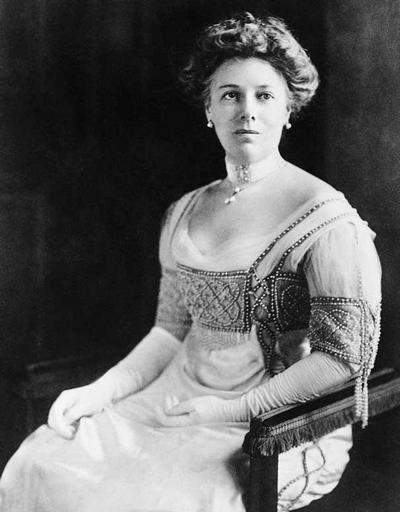Helen Taft (Helen Taft)

Born in Cincinnati, Ohio, the fourth child of Judge John Williamson Herron (1827–1912), a law partner of Rutherford B. Hayes, and Harriet Collins (1833–1902), Nellie graduated from the Cincinnati College of Music and taught school briefly before her marriage. With her parents, she attended the twenty-fifth wedding anniversary celebration of President and Mrs. Rutherford B. Hayes at the White House in 1877. Her grandfather, Ela Collins and uncle William Collins were both members of Congress.
Two years later, she met William Howard Taft at a bobsledding party in Cincinnati; he was 22 years old, she was 18. He asked her out for the first time in February 1880, but they did not date regularly until 1882. He proposed in April 1885, and she accepted in May. Taft married Nellie on June 19, 1886, at the home of the bride’s parents in Cincinnati. The wedding was performed by the Reverend D.N.A. Hoge of Zanesville, Ohio. Taft’s younger brother Horace Taft was best man. The couple honeymooned one day in New York City and four days at Sea Bright, New Jersey, before setting off on a three-month tour of Europe.
On their return, they settled in Cincinnati. Mrs. Taft encouraged her husband’s political career despite his oft-stated preference for the judiciary. She welcomed each step in her husband’s political career: state judge, Solicitor General of the United States, and federal circuit court judge. In 1900 he agreed to take charge of American civil government in the Philippines. Further travel with her husband, who became Secretary of War in 1904, brought a widened interest in world politics and a cosmopolitan circle of friends. The Tafts had two sons and a daughter. Robert Taft (1889–1953) was a political leader, Helen Taft (1891–1987) was an educator, and Charles Phelps Taft II (1897–1983) was a civic leader.
As First Lady, she was the first wife of a president to ride alongside her husband down Pennsylvania Avenue on Inauguration Day (heretofore the outgoing president had accompanied the incoming president). Two months after entering the White House, Mrs. Taft suffered a stroke, impairing her speech. She never fully recovered. With the help of her sisters, however, she entertained moderately. She received guests three afternoons a week in the Red Room. The social highlight of the Taft administration was the silver wedding anniversary gala (June 19, 1911) for some 8,000 guests.
In her most lasting contribution as First Lady, Mrs. Taft arranged for the planting of the 3,020 Japanese cherry trees that grace the Washington Tidal Basin; with the wife of the Japanese ambassador, she personally planted the first two saplings in ceremonies on March 27, 1912. In 1912, she attended the Democratic National Convention, taking a front-row seat in order to deter speakers’ criticism of her husband.
Prohibition was a major political debate at the time. Mrs. Taft was a Wet (an opponent of the Prohibition movement), so White House guests were entertained with alcohol during her time as First Lady. The former president opposed prohibition during his presidency and much of his time as Chief Justice, but was himself a teetotaler and during his last years wrote letters in support of Prohibition’s objectives. With Taft’s appointment to the Supreme Court, Mrs. Taft became the only woman to be both First Lady and wife of a chief justice. She died on May 22, 1943, and was buried next to the president at Arlington National Cemetery.
Born
- June, 02, 1861
- USA
- Cincinnati, Ohio
Died
- May, 22, 1943
- USA
- Washington D.C.
Cemetery
- Arlington National Cemetery
- Arlington, Virginia
- USA





